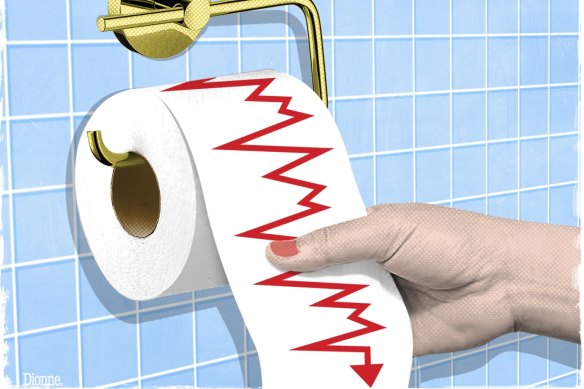
That time I bought shares on the toilet… (and other investing tips!)
In this week’s episode of our new podcast,“It All Adds Up” (look it up now!) I let slip the potentially embarrassing fact I once executed a sharemarket “buy” order with my smartphone while sitting on the toilet.
I say potentially embarrassing because there was method in my bathroom-based investing strategy, which I’ll get to.
I’m convinced buying shares directly is not for everyone. It’s crucial every investor first consider the myriad alternative uses for their money.Credit:Dionne Gain
First, let me be clear I am not recommending that you, too, buy shares on the toilet – or, even that you buy any shares directly at all.
Most Australians already own shares indirectly via the significantly more sanitised route of having their superannuation fund invest some of their retirement savings in shares (at least, I assume they don’t sit on the loo while they do it…).
About one-in-three Aussie adults – or 6.6 million people – do, however, also hold shares or other exchange-listed assets outside their super funds (although this figure includes people who own them through a self-managed super fund), according to the ASX’s latest investor study
But I’m convinced buying shares directly is not for everyone. It’s crucial every investor first consider the myriad alternative uses for their money, plus their own individual circumstances and financial goals.
Many people, for example, would be better served by first paying off any high-interest debts they hold, such as credit cards or personal loans.
Many renters would similarly be wise to consider keeping their home deposit savings in more liquid form (or exploring the government’s First Home Super Saver Scheme).
High-income earners should also consider the sweet tax breaks available on super and choose to invest that way. If you don’t mind parting with your money until after 60, that is.
You might also consider investing in property as an alternative to shares.
Consider also if you have the appetite or ability to become a “leveraged investor”. Instead of using your monthly surplus savings to buy shares directly, you could use some of your excess cash to fund a loan which would enable you to purchase a large whack of assets up front – either property or shares.
Yes, you’ll pay interest on that loan, but you’ll also enjoy potential gains on a larger asset base over a much longer period of time (or losses, of course – it’s a two-way street). Something to consider, at least, noting that banks are generally far more comfortable lending larger sums against property than shares.
Crucially, everyone needs to also make sure they are not investing money in the sharemarket that they need any time soon. Have you saved up for that quarterly water bill? Do you have an emergency fund of three to six months’ of living expenses to cover life’s unforeseen events?
Do you have adequate insurances in place to protect you? Being forced to sell your shares at an inopportune time to fund consumption needs can lead to significant losses.
You also have to consider your appetite for volatility. Are you someone who is going to freak out upon hearing the latest news about a sharemarket rout and fire-sale your shares at a loss? With term deposit rates nudging back above three per cent, perhaps you’d sleep better at night with your money in the bank and no share-trading app to check the value of your portfolio.
If you do invest in shares, you ought to be investing with at least a 7-10 year horizon in mind to ride out the volatility. Years of negative returns are not uncommon. If you’re particularly unlucky, you could pick a decade to invest in which shares experience below-average annual gains.
Share purchases should be made because you have surplus cash to deploy, and you want to build wealth over the long term.
Do it because you understand what share investing actually is. It’s buying yourself a part-ownership in a business (or group of businesses) that should, over time, be able to pay you a share of their profits (called dividends).
As humans become more efficient at combining the key inputs of labour and capital – thanks to technology and other gains – it’s reasonable to expect the value of your shares to grow over the long run.
When I first set out to invest in the sharemarket, I was curious to try a strategy of investing in single stocks across multiple industries.
However, I quickly converted to a strategy of investing in low-cost exchange-traded funds, which passively track the returns of a broader sharemarket index. Today, my portfolio contains indices covering both Australian and international markets, to ensure I am diversified across different industries and geographic locations.
My investing goal is to perhaps be able to retire – or at least become work optional – before age 60, when I can access my super. If not, no worries, Future Jess will just have to keep working. Investing is a risk I’m willing to take to perhaps enjoy a higher return on my money than keeping it in the bank.
So, after tracking my spending and income each month (including setting aside regular amounts for future big expenses such as holidays, a car and household costs) I sit down to calculate my budget surplus and decide how much of it I want to transfer to my brokerage account to invest.
I still get a bit nervous each time it comes to actually converting my cash into the more abstract and risky business of an ownership stake in companies.
To lend the situation some levity, I did once execute a share “buy” order while on the loo. Share purchases only take a matter of seconds electronically these days (I place my orders at market price, rather than attempting limited orders below the buy-sell spread).
- Advice given in this article is general in nature and is not intended to influence readers’ decisions about investing or financial products. They should always seek their own professional advice that takes into account their own personal circumstances before making any financial decisions.
Jessica Irvine is co-host of the new podcast It All Adds Up and author of the book Money with Jess: Your Ultimate Guide to Household Budgeting. You can follow more of Jess’ money adventures on Instagram @moneywithjess and sign up to receive her weekly email newsletter.
Most Viewed in Money
From our partners
Source: Read Full Article
